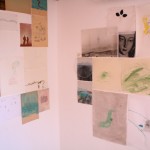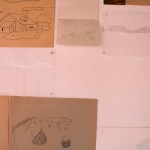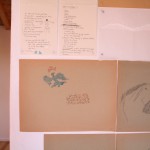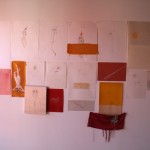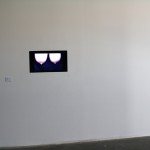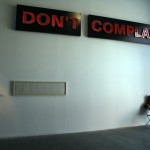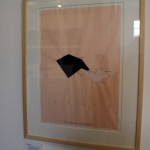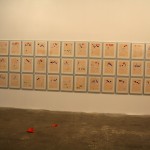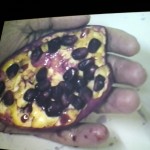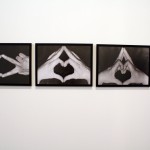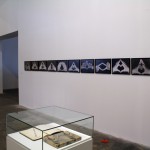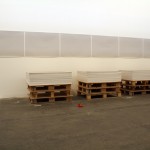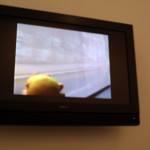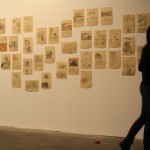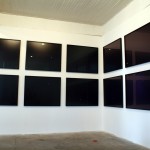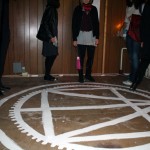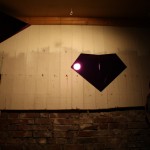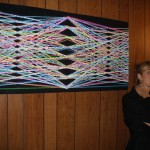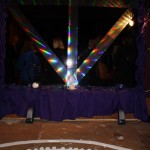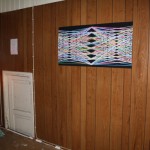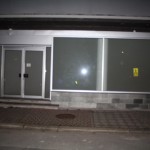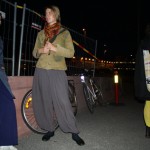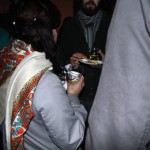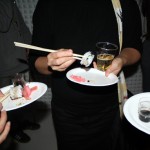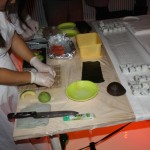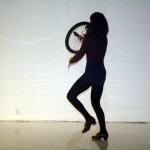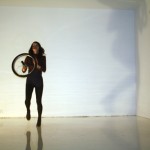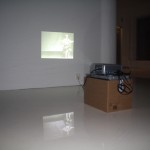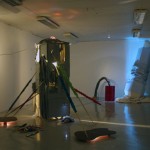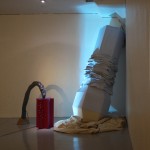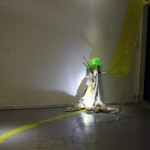11th International Istanbul Biennial
All posts by Julie Lillelien Porter
Biennalebetrakninger 2
I tillegg til biennalekonferansen som fikk mye oppmerksomhet blant byens kunstnere og tilreisende kuratorer var det også interessante kunstprosjekter å oppleve i byen denne helga.
På Volt, som for utstillingen “0,(0)4%” hadde visningsstedet sitt i et meget karakteristisk lokale i Nykirkeallmenningen, var det Josefine Lyche og Henrik Pask som viste en installasjon med små-okkult preg som var utrolig forfriskende. “Utstillingen kombinerer tekst, geometriske figurer, lys og skygger i forsøk på å kommentere vår sykliske korrespondanse med universet“.
Det er godt å vite at Volt fortsetter driften etter å ha flyttet ut av den gamle kloakkstasjonen, med nye stedsspesifikke og prosjektbaserte visninger på litt “unormale” plasser. Veldig bra!
På lørdagen var det duket for live performance med Glasgow/København-baserte Molly Haslund.
Haslund var blitt invitert til å ta ibruk de nye lokalene til Bergen Kjøtt på Nøstet gjennom en ti-dagers residency for anledningen.
“Gjennom sine performancer og installasjoner viser Molly fram et fysisk og (sur-)realistisk univers. Hun pikturerer gleder og vanskeligheter oppdaget gjennom dagligdagse objekter og invensjoner så vel som kulturelle ritualer og readymades. Forsøkene og utfordringene hennes lager poetiske og visuelle paradokser av gledesfylt melankoli”
Da man inntok lokalene møtte man totalt tåke-/røyklagte omgivelser, der mulighetene til å se og bli sett nærmest var lik null. Istedet opplevde man en avslappet tilstedeværelse av sin egen kropp som smøg seg sakte rundt i rommet. Selve live-performancen tok til både oppe i andre etasje og ute på kai-området, var sammensatt av flere fysiske innspill og varte tilsammen i en time.
Program for kvelden var:
1. ‘Ice’ – eat it or let i melt – ( room ground Floor, begins 20.30 )
2. ‘Hunting’ ( performance, watch from window 1st floor )
3. Food making by Tor Evert Johansen and Linda Soh Trangereide 1st floor
4. ‘ Smart Addiction’ A readymade wheel performance ( 1st floor)
5. Food and drinks for guests ( 1st floor)
6. Exit via ice room ground floor – (‘Girl On Fire – Ela Lola 1898’)
På søndagen valgte jeg å besøke et åpent prosjektrom på Kunstakademiet der Nathalie Fuica Sánchez hadde arbeidet med en skulptur-og lydinstallasjon den siste uka. Der var det påfallende rå voodoo-stemning med imponerende utdrivende stemmeopptak.
Med andre ord: en biennalekonferanse-helg i Bergen med kvalitet på de kunstnerdrevne plassene.
Foto: Julie Lillelien Porter/Nathalie Fuica Sánchez
Betydningen av samarbeid vil bli tydelig reflektert i denne utstillingen
En interimrapport fra C/O Visningsrommet USF
Jeg følger med på websidene til Summer of Production. Jeg er ikke fysisk tilstede i Bergen denne sommeren, og det som er bra er at jeg kan følge med på hva som skjer på Visningsrommet USF uten å være der. Fra her hvor jeg er, er utstillingen tilslørt av verdensvevens distanse. Jeg kan se at gjennom de fire–fem ukene utstillingen har eksistert, har det i rykk og napp blitt lagt ut billed- og tekstmateriale som dokumenterer prosessen som foregår mellom 17 forskjellige involverte kunstnerne.
Continue reading Betydningen av samarbeid vil bli tydelig reflektert i denne utstillingen
Tid for det organiske
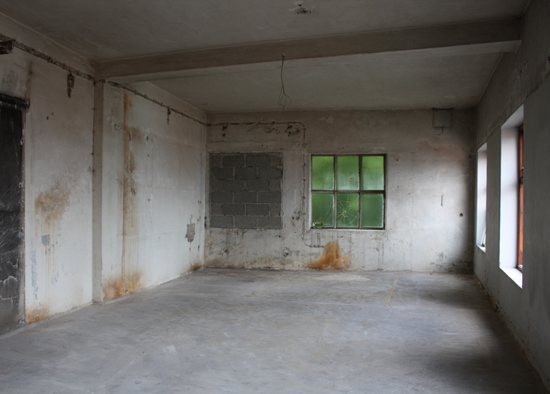
I løpet av 2010 vil BERGEN KJØTT stå ferdig oppusset med arbeidsplasser for tilsammen 40 kunstnere og musikere i Bergen. Den 2000 m² store bygningen nederst i Sandviken består av fire etasjer som vil romme atelierplasser, prosjekt- og visningsrom, øvingslokaler og musikkstudio, samt kafé. Initiativtakerne til prosjektet BERGEN KJØTT er kunstnerne Annine Birkeland og Agnes Nedregård, og hovedideen bak prosjektet er å skape en plass i Bergen hvor lokale og internasjonale kunstnere og musikere kan møtes, sette i gang prosjekter og jobbe sammen. De ønsker å tilrettelegge for prosessene som oppstår mellom folk, og å stole på at dette i seg selv skaper et dynamisk miljø. Continue reading Tid for det organiske
Vs. Glasgow: Interview with Francis McKee about the biennale form
This autumn a “Biennale Conference” will be held a conference in Bergen in order to discuss the possibility of organising and starting up a contemporary art biennale in the town.
I decided to interview Francis McKee, former director of Glasgow International Festival of Contemporary Art, which now has taken on the form of a bi-annual festival in Glasgow.
JLP: Could you explain the starting point of the GI festival, such as who initiated it, on what background, and what were the strategies to make it become successful?
FM: GI grew out of the Glasgow Art Fair, – an annual fair in the city around April which predominately sells traditional paintings, nothing contemporary or that would be recognized as such in the contemporary art world. The organisers of the art fair thought it would be good to start a small associated festival that would encourage the visitors of the fair to go to the local galleries and museums as well. I was hired as a freelance curator and given the job of creating the first festival. It was clear to me though that the contemporary art community in the city and the various galleries such as Transmission, The Modern Institute etc wouldn’t want to take part if it followed the pattern of the Art Fair. I instituted a policy which said that everything would be curated and I cut the link to the art fair, creating separate marketing, brochures, posters etc. Galleries could only take part if I invited them to be in the festival and proposals could be submitted but could only happen if I permitted them. This ensured that there was a standard for the work from the beginning. For me, the art fair had failed to gain contemporary art credibility by diluting the mixture of galleries and levels of art. If everyone could see there was a clear standard being set then the best local groups and organisations would be willing to take part.
The other key decision was to then give the local galleries and groups funds to spend on their own projects. They would submit proposals and then they would receive funds directly to go ahead and curate those projects. The key curatorial decision for me then was to select the organisations and proposals that would be in the festival. After that many of them would be curated separately. I was relying on the fact that it was those galleries like Tranmission, Modern Institute, Sorcha Dallas, Mary Mary and others that had created a reputation for Glasgow in the first place. It seemed to make sense to draw on their strengths and showcase what they normally do rather than take everything over and drop projects into their spaces. Supporting their proposals also meant they felt more ownership over the festival and wanted it to work.
JLP: How did you as the director define your relationship between working with artists involved versus working with sponsors, decision-makers, politicians in the council, etc?
FM: Two very different experiences. While you always find some politicians, funders or decision-makers who like art you also have to deal with a majority who don’t know much about it. Working with this sector you have to remember that their interests are different and that is not necessarily a negative thing. The city council for instance wants a festival that is good for the city’s economy and also good for its cultural image. Its about bringing visitors to the city who spend money and creating a reputation for the city as a cultural centre as well as commissioning new art. That’s all to be expected – a council generally thinks of the city’s economy and wants to invest in it, especially in a city like Glasgow where something has to replace lost industry and jobs. As long as you can recognize this and create a festival that meets those needs as well as remaining credible as an arts festival that’s not a problem. I was lucky in Glasgow as the council has been working like this for some time. They are now quite sophisticated in their approach to the arts and mostly they realize that it’s best not to interfere, recognizing that the various organisations and artists in the city have gained an international reputation for their work. I found a lot of support among funders who gave me great freedom to programme what I wanted and let me organize the festival as I wanted. This allowed me to build a model based on grassroots organisations and groups in the city, creating a very different feeling from more ‘glossy’ festivals. Even when I ran risks – a dangerous high wire walk, controversy over various works – the council remained supportive and understood that the audience was mature enough to cope with such things. That support was crucial. Working with artists was very different. It was important to distance them from the bureaucracy of dealing with funders and councils and to focus on the commissioning of art and supporting that process. To bring that bureaucratic language to the art community would have killed the spirit of the festival. At the same time, the bringing together of so many organisations did allow the art community to see just how large it was and to discover corners of their world that even they did not know about. Art is tribal in Glasgow and so many organisations didn’t have contact before the festival and I think it helped make everyone more aware of each other. It also allowed several organisations to see the possibility to grow and become more established. Basically, though, art has to be the focus of everything when talking to the art community, the curator/director’s job is to shoulder the administration and leave artists free to concentrate on work.
JLP: Do all of these parties have the same goal for the festival, do you think?
FM: Not necessarily. The city’s policy of creating a ‘creative community’ is very much influenced by the ideas of Richard Florida in the ‘90s and at times can come close to instrumentalising art, employing it as a tool of urban regeneration. Many cities have taken this approach. Arts organisations do see the advantages of some of this too – I think, for instance, it also benefits the commercial galleries to have the city promoting the artistic and cultural profile of Glasgow if it’s done well. Artists personally are less interested in this and find themselves occasionally at the mercy of the process – as areas become more popular they are moved on to another less well off district. Or in Glasgow’s case, the creation of a ‘cultural quarter’, which redevelops artistic spaces, is greeted with some ambiguity as the upgrading also raises fears of homogenization of the arts scene. It’s important to recognize that everyone looks at a biennale selfishly – the improvement of the city’s cultural profile for the council, the acceleration of momentum for private galleries, the kudos of high profile shows for curators and the international exposure and commissions for artists. That can all be harnessed to create a successful biennale though that doesn’t have to be a commercial orgy!
JLP: Do you feel that you get a balance between the art community in Glasgow and the international art scene?
FM:I think that the last GI did do that. The first two were on much smaller budgets so there was an attempt to represent the international scene through works that could be introduced to the UK for the first time. As they were annual festival with a smaller budget there wasn’t time or money to commission larger scale works from international artists as typically there was six months between commissioning and opening the festival. It’s important to remember though that a significant number of artists with an international reputation live in Glasgow itself – perhaps a larger number than a city of that size should be able to claim. There is a very large artistic community (with a very international mix in its population) and the city punches above its weight in that regard. With the move to bi-annual festivals and a significant funding increase it became possible to credibly commission art from the best known artists.
JLP: What ideas do you have about the biennale concept, e.g. how broad, open, new, bold or how controlled, curated and safe?
FM: Personally I have favoured a very broad and open approach with a very loose curatorial style. I think this is not very often used because reputations are more easily built on total control and curatorial branding. I don’t think Glasgow would take too kindly to this approach however – it is founded on independent movements and communal actions. Moreover, the curatorial brand model is tired and redundant – even more so in the post economic crash of the art world. There is an opportunity now to rethink the biennale model radically. In fact this is more than an ‘opportunity’. I think it is a necessity if something viable is to emerge. The old models don’t work any more.
JLP: How involved are local artists in the festival?
FM: Local artists have been very involved – their commitment to the festival is one of the reasons for its success and for its different ambiance. If that is lost then the festival becomes an alien thing that will be rejected by the art community and the city.
JLP: How is the cooperation around decision-making within the process of what is a successful biennale? What are the “criteria” for this success? What is your advice?
FM: I think the criteria may be different for each festival. What works in Glasgow doesn’t work for Venice, Liverpool or Sao Paolo. I think open minded, supportive and imaginative funders can help enormously. It also helps if they allow the creative directors freedom to follow their vision. Each biennale has to look to its own circumstances to see what it can create that justifies its existence. This is particularly important in more marginal cities such as Glasgow. Why should a visitor go that extra distance to see artists and work that could be seen in London, Berlin or New York. For marginal places the answer is often in the local ambiance – the extra bonus of the culture surrounding the exhibition which is different from the homogenized feeling of larger cosmopolitan cities. Equally, a fresh approach to the presentation of contemporary art can be the justification. So many exhibitions, art fairs and biennales are stale repetitions of tired formulas. The art world is very fashion conscious and, paradoxically, this can make it very conservative. Everyone wants the tried and tested product because they want to be seen to make the right choices. This makes many organisers afraid to be different. It is also useful to remember that biennales are often mass events and although they have to attract the international art world’s attention on the opening days, they also have to appeal to a broader public throughout the remainder of their run. That doesn’t have to mean compromise but it does have implications in the way in which the biennale is talked about. Language from the extremes of theory, for instance, can be off-putting and incomprehensible to the majority of art visitors but then, anyone intelligent enough to understand that theory should be intelligent enough to make it comprehensible to a wider audience…
JLP: How have you been successful in continuing the festival- why have you decided to have a biennale, and does the biennale construct an identity for Glasgow?
FM: The festival has been successful because the art community and the funders have all given it their blessing and they all agree it works. I argue below that Glasgow’s biennale works because it is more than city branding – there is a vital, large, arts community that is producing significant work that is recognised internationally. The funders, of course, see the various economic and city branding opportunities but they are sophisticated enough to let the festival develop in its own way and not to force its direction. Equally, visitors sense that the festival is built on genuine local activity and the claims for artistic activity in the city are not exaggerated. That makes it credible amidst a stream of artificially induced biennales across the world.
JLP: What is the gain for the art community in Glasgow?
Francis: The art community which works so hard all year round, gets a platform to present itself to an international audience and, hopefully, with additional funds to be more ambitious in its presentation. There is also a vital networking opportunity as the arts council invites a series of international curators to visit Scotland during the festival – so local artists, whether they’re in the festival or not, have an opportunity to present their work to curators and the curators have a chance to get to know some of the art landscape of Scotland.
JLP: Why does it work for Glasgow to have a biennale?
Francis: That’s a question that has to be asked at regular intervals – I don’t think any event can assume it remains relevant. If it can regularly answer the question in the positive then it can continue (Edinburgh arts festival, for instance, has changed its function dramatically from its original form and it arguably exists for different (but good) reasons now).
I think at the moment Glasgow has such a large and active arts community (and so many of them internationally recognized) it makes sense to celebrate the activity in the city. I think Glasgow has the largest visual arts community outside London and perhaps a closer knit community than London itself. That creates a great sense of common purpose and it provides a great basis for a festival – there is something genuine to celebrate at the moment rather than creating a biennale just for the sake of city branding.
JLP: What is a successful biennale do you think?
Francis: A biennale that exists for a genuine purpose can be successful. It needs to know what it wants to achieve and there needs to be a good reason for its existence. If its simply inspired by a desire to look chic or to compete with other cities, it can quickly look shallow and visitors can spot this easily. A biennale is really a celebration so there needs to be a genuine reason to celebrate. It doesn’t always need to be based on local, geographical, arguments – Venice Biennale doesn’t work because there is a great local community of artists, in fact everything about Venice should work against a festival as it is a logistical nightmare. But it provides a unique backdrop and culture that gives it character. Other festivals in some cities seem nothing more than an event promoted cynically by a conglomerate of local commercial interests.
Interview by Julie Lillelien Porter
